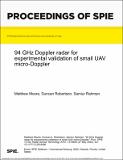94 GHz Doppler radar for experimental validation of small UAV micro-Doppler
Abstract
The micro-Doppler signature of a small unmanned aerial vehicle (UAV), resulting from the rotation of propeller blades, can be used to differentiate UAVs from other common confusing elements such as birds. Moreover, the micro-Doppler signature varies depending on the shape of individual UAV components such that these signatures can be used to differentiate between different UAV models. In order to investigate how different UAV components affect the signature, a high-fidelity micro-Doppler simulation has been developed previously, capable of generating micro-Doppler returns from 3D CAD models. This simulation requires experimental validation and so a 94 GHz radar has been designed and built for lab-based micro-Doppler measurements of UAV components in CW or FMCW Doppler modes. This allows for controlled experimental recreations of simulated scenarios in which the experimental micro-Doppler signatures of different UAV components can be measured and used for robust simulation validation. In this paper, the radar design will be explained in detail and the radar performance will be reviewed. Chirps are generated around 1 GHz using an Analog Devices AD9914 DDS board and upconverted onto a low phase noise STALO at 6.833 GHz. The upper sideband is filtered and frequency multiplied by 12 to 94 GHz. In FMCW mode the maximum chirp bandwidth is 3 GHz. The receiver is homodyne using a 94 GHz I-Q mixer to de-chirp to baseband. Feedhorn antennas are used for close range lab measurements, but larger antennas could be fitted for longer range outdoor data collection.
Citation
Moore , M , Robertson , D A & Rahman , S 2022 , 94 GHz Doppler radar for experimental validation of small UAV micro-Doppler . in K I Ranney & A M Raynal (eds) , Radar Sensor Technology XXVI . , 121080S , Proceedings of SPIE - The International Society for Optical Engineering , vol. 12108 , SPIE , Bellingham, WA , Radar Sensor Technology XXVI 2022 , Virtual, Online , 6/06/22 . https://doi.org/10.1117/12.2618496 conference
Publication
Radar Sensor Technology XXVI
ISSN
0277-786XType
Conference item
Description
Funding: The authors acknowledge the financial support of the Engineering and Physical Sciences Council and QinetiQ (PhD funding for MM).Collections
Items in the St Andrews Research Repository are protected by copyright, with all rights reserved, unless otherwise indicated.

